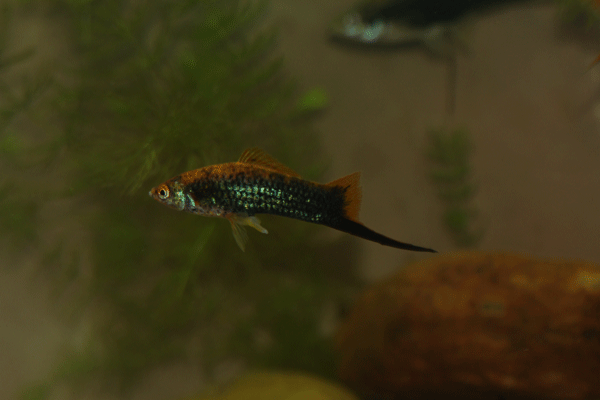Photo: An early male Blue Iridescent Swordtail used in the development of the strain.
We raise a variety of commercial swordtails. While these fish closely resemble the shape of the wild swordtail Xiphophorus hellerii, they are hybrid strains with genes from other Xiphophorus species such as X. variatus and X. maculatus. All three of these species, as well as other members of this genus, readily hybridize. One commercial swordtail strain we raise is the Black Swordtail. From this strain in July 2014, I isolated some fish showing blue iridescence in the black on the body. Hence the name Blue Iridescent Sword; as usual I’m very talented at coming up with catchy names! The male in the photograph is one of the early fish.
We recently processed the Blue Iridescent Swords. By “processing,” I mean we netted out the breeders from the breeding colony vat after removing the fry cage and hornwort (a rootless, floating plant) that provide cover for fry and juveniles. Our breeding colonies are usually three to six males and 40 to 60 females, but often less in strains we are trying to set or improve. The fry and juveniles are left in that vat and allowed to grow for about three more months.
For our established strains we usually have three vats, the breeding colony, the juvenile grow out vat, and sale vat. For new strains like this one we don’t have a sale vat. So, after removing the breeders and setting up juvenile vat we net out the fish from the prior juvenile vat. These fish are now adults. We sort these fish into potential breeders; those that look closest to what I imagine the resulting strain will be, and fish that won’t be breeders. The latter are moved to our mixed swordtail vats and are sold as such to our retail store customers.
The potential breeders are compared to the old breeders and the best are segregated into a new breeding colony. The others go to the mixed swordtail vats. In the case of the Blue Iridescent Swords, this time we kept only four fish, one male and three females. Why so few? Because, these four were the best, meaning they more closely matched my mental image of what a Blue Iridescent Swordtail should be. I didn’t photograph the fish so you could see the improvement in the strain from the pictured male because I didn’t want to stress them any more lest I lose one or more. This has happened in the past. I’ll photograph the new strain after I have plenty of fish to work with.
The Blue Iridescent Swordtail I envision will have a solid black body covered with blue spangles. The fins will be red. The eye will be red. The male’s sword will be jet black.
Now, Susie, my wife and business partner, takes a dim view of my “experimental” fish since they occupy valuable greenhouse space and generate no revenue. So, this line is under the gun for rapid development into a strain that sells and justifies its existence. That seems a bit mercenary to me, but that’s life (or death for the fish strain!).
Good fishkeeping!


chuck says
I believe a blue iridescent sword would be a big hit. The current blue swords are kind of washed out. If you could capture the same irridescense as the blue platy, you would have something unique , especially on the black background.
charles says
Chuck, I’m planning a cross using a male blue iridescent sword with blue maculatus to see if the blue can be expanded and intensified.
Gregg L. Friedman MD says
I agree that a cobalt blue iridescent sword would be a beautiful addition to any aquarium. I hope that these will become available in the near future.
Charles Clapsaddle says
Gregg, Most of our livebearer breeding projects have been put on hold. We are renovating and repairing our livebearer greenhouse which suffered significant damage from Hurricane Harvey.